VALUE OF SHOULDER MR - ARTHROGRAPHY IN THE DIAGNOSIS OF SUBACROMIAL IMPINGEMENT SYNDROME
Main Article Content
Abstract
Purposes: To evaluate the value of MR- arthrography in the diagnosis of subacromial impingement syndrome. Matherial and Method: The cross sectional descriptive study on the patients who underwent the shoulder MR - arthrography and surgery. Then, the rotator cuff lesion diagnosed on MR- arthrography was compared to the surgery to evalutate the sensibility, specificity and accurate diagnosis of this method. Results: From 1/2016 to 9/2022, fifty patients who underwent the shoulder MR - arthrography and surgery at Hanoi Medical University Hospital. Among them, 19 patients were diagnosed the subacromial impingement syndrome in the shoulder MR - arthrography and then surgery. The sensibility, specificity and accurate diagnosis of MR - arthrography for the diagnosis of the subacromial impingement syndrome were 100%, 93.3% and 96% respectively. Conclusion: Shoulder MR- arthrography was the high value method to diagnose the subacromial impingement syndrome
Article Details
Keywords
subacromial impingement syndrome, supra-spinatous tenton compression, MR arthrography.
References
2. Stoller, D.W., Magnetic Resonance Imaging in Orthopaedics and Sports Medicine, Chapter 8 The shoulder. 3rd ed. 2007: Lippincott Williams & Wilkins.
3. AM, D., Imaging of the Shoulder: Techniques and Applications. Diagnostic Imaging. Springer.
4. Shoulder impingement syndrome: sonographic evaluation. Radiology, 1990. 176(3): p. 845-9.
5. Stoller, D.W., Magnetic Resonance Imaging in Orthopaedics and Sports Medicine, Chapter 8 The shoulder. 3rd ed. 2007: Lippincott Williams & Wilkins.
6. Hà, P.C., Báo cáo kết quả bước đầu ứng dụng kỹ thuật chụp cộng hưởng từ khớp vai với tiêm tương phản từ nội khớp. 2006.
7. Hardy, D.C., J.B. Vogler, 3rd, and R.H. White, The shoulder impingement syndrome: prevalence of radiographic findings and correlation with response to therapy. AJR Am J Roentgenol, 1986. 147(3): p. 557-61.
8. Getz, J.D., et al., Acromial morphology: relation to sex, age, symmetry, and subacromial enthesophytes. Radiology, 1996. 199(3): p. 737-42.
9. Saupe, N., et al., Association between rotator cuff abnormalities and reduced acromiohumeral distance. AJR Am J Roentgenol, 2006. 187(2): p. 376-82.


